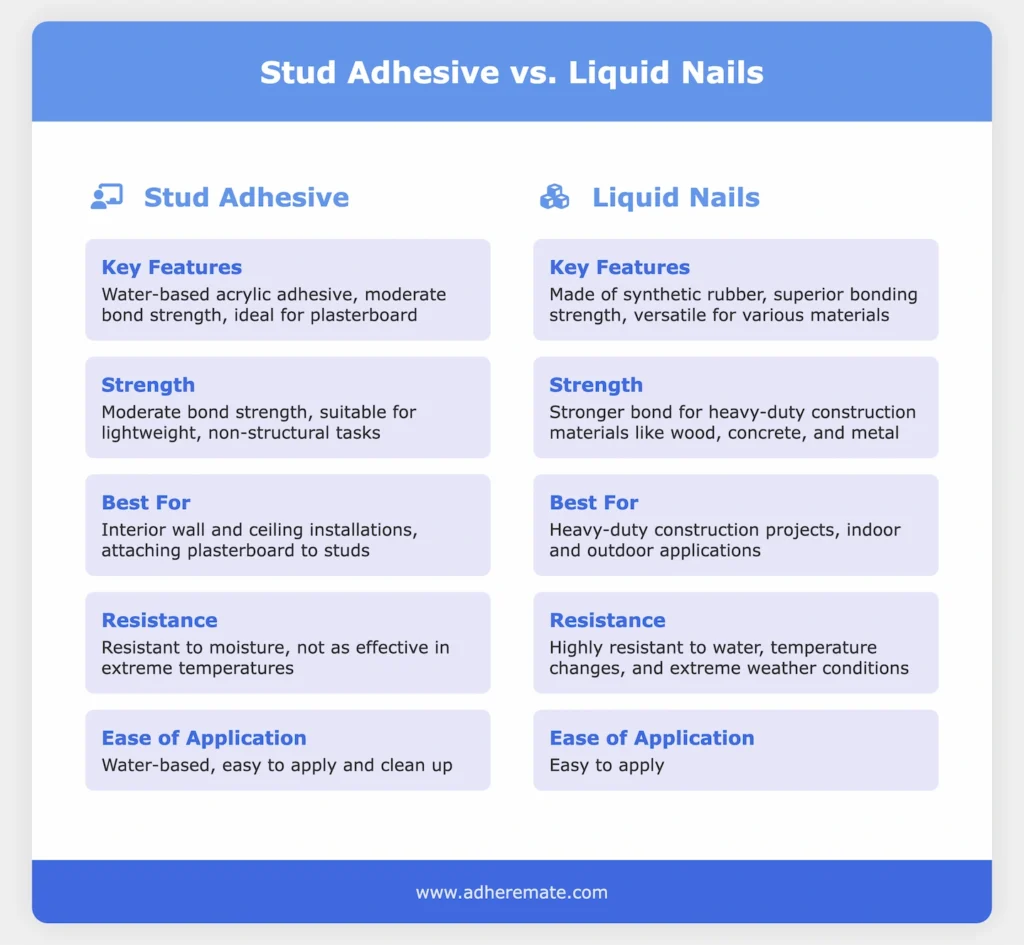People compare Stud Adhesive and Liquid Nails to find which suits their project better. It often lead to confusion and they might pick the wrong one.
Stud Adhesive is mainly for plasterboard and its easy to apply but less versatile. Liquid Nails is stronger and can bond various materials like wood, metal, and stone.
While Stud Adhesive is ideal for drywall installation, Liquid Nails offers better strength and flexibility for larger, heavier-duty projects.
Read the article further to learn more about their comparison.
If you’re working with wood, it’s also worth exploring the differences between Liquid Nails and Wood Glue for specific wood bonding tasks.
Article Highlights
- Stud Adhesive is a water-based acrylic adhesive with moderate bond strength.
- Liquid Nails contains synthetic rubber and chemical solvents for stronger bonds but more challenging cleanup.
- Stud Adhesive is moisture-resistant but struggles in extreme temperatures.

Stud Adhesive vs. Liquid Nails
Strength
Stud Adhesive is a water-based acrylic adhesive with moderate bond strength. It’s ideal for lightweight, non-structural tasks like attaching plasterboard to timber or steel studs. Stud Adhesive also has a strong bond for interior walls and ceilings. However, it is not suitable for heavy-duty tasks.
Liquid Nails is also known for its superior strength. It’s made with synthetic rubber, making it better for bonding materials like wood, concrete, or metal. Its flexibility allows it to handle vibrations and expansions. So, you don’t have to think about dynamic environments.
Purpose
Stud Adhesive’s main purpose is to create a strong, flexible bond that reduces the need for screws and nails during installation. It’s Ideal for interior applications, particularly in wall and ceiling installations.
On the other hand, Liquid Nails is mainly used for attaching construction materials. Because of their different purposes, Stud Adhesive cannot fully replace Liquid Nails. Acrylic-based Stud Adhesives are generally softer, with a quicker grab, and better for interior applications involving plasterboard.
However, they may not handle outdoor conditions, temperature variations, or other materials as effectively as synthetic rubber-based adhesives like Liquid Nails.
For more insight into construction adhesives used in multi-material projects, check out the comparison between Gorilla Glue and Liquid Nails, particularly when working with various materials like wood and metal.
Chemical Composition
Most Stud Adhesives are water-based acrylic adhesives made with acrylic polymers. They are eco-friendly, with fewer VOC emissions, but their use is limited to non-structural applications.
Moreover, Stud Adhesive is easy to clean, safe for users, and suitable for bonding plasterboard to studs and frames. However, it’s not as strong or durable in extreme cold, heat, or wet environments. The chemical composition makes it less versatile when bonding various materials beyond plasterboard.
Liquid Nails come in various formulations, each suited for different applications. The standard version is made from synthetic rubber and is known for its superior bonding strength across materials like wood, concrete, and metal. There are also low-VOC (Volatile Organic Compounds) versions available.
These are safer for indoor use, have minimal odor, and are environmentally friendly. Some Liquid Nails products are specifically formulated for quick-drying, heavy-duty applications, while others are tailored for delicate indoor tasks.
Choosing the right variant ensures you get the best results for your specific project, whether it involves heavy-duty construction or more delicate interior work.
Resistance
Stud Adhesive is resistant to moisture and light. However, it may not perform better under extreme temperature conditions than synthetic rubber.
Stud Adhesive works well for interior applications where the environment is stable and does not experience harsh conditions.
On the other hand, Liquid Nails is highly resistant to water, temperature changes, and extreme weather conditions. It is better suited for indoor and outdoor projects, particularly those exposed to moisture, heat, or cold.
Versatility
Stud Adhesive is less versatile than Liquid Nails. Where Liquid Nails can bond a wide range of materials, Stud Adhesive is limited to plasterboard and internal framing.
Moreover, you can use Liquid Nails for indoor and outdoor projects, but you must use Stud Adhesive mostly for indoor projects.
Ease of Application
Stud Adhesive is generally easier to apply because it is water-based and can be cleaned up with water. It is more user-friendly, especially for DIY projects or interior jobs that don’t require extremely strong bonds.
On the other hand, Liquid Nails is thicker and may be more challenging to apply evenly. However, it is known for its instant grab and ability to hold materials in place quickly, reducing the need for clamps or fasteners in some applications.
Cure Time
Liquid Nails generally bonds in 10-30 minutes, but full curing times can vary based on factors such as temperature, humidity, and the specific product formulation.
While it can cure faster than Stud Adhesive under optimal conditions, some low-VOC or specialized variants of Liquid Nails may take longer.
Similarly, Stud Adhesive typically cures in 24 to 48 hours, but this time may be extended or shortened depending on environmental factors.
It’s crucial to consider the working conditions (e.g., extreme heat or cold) when comparing the curing times of these adhesives to avoid unexpected delays.
Drawbacks
Stud Adhesive has a limited scope for bonding. As a result it is unsuitable for heavy materials, exterior use, or environments with high moisture. It also requires screws or nails for added support, especially on ceilings.
Liquid Nails have a strong odor, which may harm some customers. It is also messy and harder to apply evenly. Sometimes, you may need good ventilation to use Liquid Nails. It is also hard to clean up.
Editor’s Opinion
Both Stud Adhesive and Liquid Nails are known for their bond strength. I like Stud Adhesive because it’s easy to use for interior projects, especially when working with plasterboard. It’s user-friendly and easy to clean up.
On the other hand, I’m impressed by Liquid Nails for its raw strength and versatility. It’s ideal for heavier-duty tasks that require a strong, durable bond.
Overall, I’d recommend Stud Adhesive for indoor, lightweight, precise projects like drywall installation and Liquid Nails for heavy-duty, multi-material, or outdoor work that demands a tough bond.


